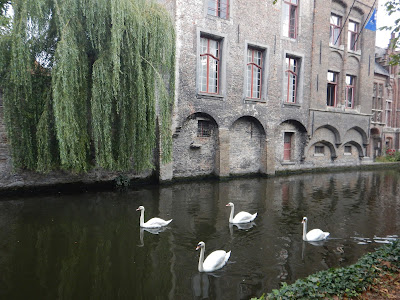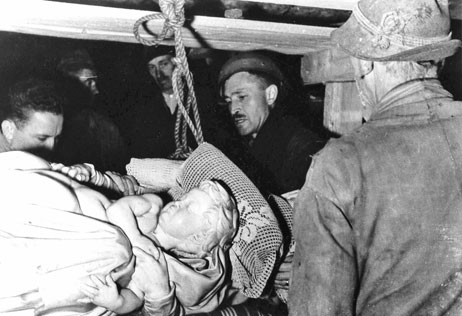Friday, August 19, 2016
Today we are in Flanders, not the field but the northern area of Belgium that is Dutch speaking.
We docked in Zeebrugge which is of little consequence except for the fact that it is 15 kms from Brugge (known as Bruges in English), where we wanted to go. Of course, the ship would take you there for $25 each (OUCH!), but through Cruise Critic, we found other people to share a taxi with which was alot cheaper. Ron and Nancy organized it and all we had to do was sign up. Morven and Uwe signed up too which was funny because we can't stop running into them. A "taxi" is a van that fits 8 people, and is €100 return. Making the total for each of us only €12.50 return. Which left lots more money for Belgian chocolate, yum.
Once we got into Brugge, we just walked around on our own for the day, which was nice.
Brugge was established by the Romans and was quite an influential trading port during medieval times (it still smelled like it!), but now it is mostly a leading tourist attraction. It has tons of canals and bridges, and the name probably comes from the word "bridge". Brugge has been called the Venice of the North. Aren't they all?
Imagecredit:http://transfers2airports.com/ckfinder/userfiles/images/bruges-canals-01.jpg
The Church of Our Lady was started in 1220 and took two centuries to complete. It has a brick spire which is the 2nd tallest brickwork tower in the world at over 400 ft.
imagecredit:https://upload.wikimedia.org/wikipedia/commons/thumb/7/78/Church_Of_Our_Lady_Bruges.jpg/220px-Church_Of_Our_Lady_Bruges.jpg
By Bundesdenkmalamt Wien - http://www.art-magazin.de/szene/66871/mission_michelangelo_bookmarks?cp=2, Public Domain, https://commons.wikimedia.org/w/index.php?curid=32126139
The church also contains the tombs of Charles the Bold (died 1477) next to his daughter Mary of Burgandy (1482), who died at age 25 when she fell off her horse.
We took a canal trip for 30 minutes. Rozenhoedkaai is a very famous area for photographs.
St Salvator's Cathedral was built in the 10th century. The artwork in this cathedral is spectacular. There are wall carpets from 1731; murals from the 1200s; medieval tombs; and a podium from the 1500s. The whole place was undergoing renovations.
Imagecredit:http://gb.fotolibra.com/images/previews/1230935-gilded-altar-piece-in-the-the-sint-salvator-cathedral-saint-saviour-is-the-main-church-of-the-ci.jpeg
It is surrounded by beautiful, ornate medieval buildings that have now been turned into cafes and restaurants. Anton had a Belgian waffle and Frankie had Belgian fries. They tasted exactly the same as any other fries except they came with a side of mayo instead of ketchup. The mayo was good, though.
The toilets here had a mind of their own. You waved your hand over it to flush it, then an arm came out of the back of the toilet to dribble water into the bowl while the seat LITERALLY did 2 circles around. Weird.
The Markt contains the Belfort (Belfry), built 1240. This building used to be the city treasury and lookout post. There are 366 steps in the bell tower that you can climb for a view of the city. The tower has a slight lean to it. Anton looked into climbing it, but he said that for 10 euros, they had better carry him up.
The Stadhuis (Town Hall) was built in 1375 and has been the seat of local government for over 600 years. Inside, it was €4 to see the ornate Gothic Hall.
Next to the Stadhuis is The Basilica of the Holy Blood, which was built in the 1100s to be the chapel for the residence of the Count of Flanders. It contains a holy relic which claims to be the blood of Jesus collected by Joseph of Arimathea. The vial has never been opened. Every year on Ascension Day, the vial is paraded through the streets of Brugge.
Imagecredit:http://www.thecatholictravelguide.com/BrugesKnight__holy_blood_3.jpg
We entered the Basilica expecting to see the relic behind glass somewhere, but ended up being part of a "Veneration Ceremony". It was one lady's job just to shush people, while the priest presented the vial to us. We could all go up to the altar and put our hands over the vial of blood to pray. The priest said we could leave a donation if we wished. While we were talking about how much to donate, we got shushed by the lady. Frankie commented on that to Anton, and we got shushed again. I guess she takes her job pretty seriously. These people REALLY believe that this is the real blood of Jesus.
We met our group back at the Markt to catch the 2:30 taxi back to the ship.
Most evenings we have had dinner next to Marge and Ken and enjoyed being spoiled by Ernan and Lucia.
We went to (most of) the show which was a mentalist tonight. We were curious. He claimed to be some sort of mind-reader, but he was slow and boring. Maybe he lacked presentation?
We are packed, ready to get off the ship bright and early tomorrow morning, and ready to spend 3 days in Amsterdam.












No comments:
Post a Comment